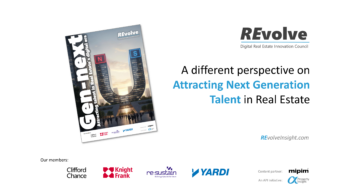Space-as-a-Service professionals including Dr. Amol Sarva, CEO and Co-Founder, Knotel; Ryan Simonetti, CEO and Co-Founder, Convene; Georgia Collins, EVP Global Client Solutions, Hana; and Charlie Hobey, Managing Director – Product and Operations, EQ Office, met online to discuss how innovation is likely to help the industry overcome its current trials, and the potential direction for the future of real estate technology. Minta Kay, Partner and Chair of Goodwin‘s Real Estate Industry group, moderated the discussion.
The panel’s industry leaders confirmed that the challenges had been significant so far for flex space operators, but suggested that certain pandemic outcomes – such as the shift away from working in traditional office spaces – could have upsides. Simonetti said: ‘I believe you have to innovate your way out of situations like this. We view this really as the great accelerator for a lot of the trends around how people work and their desires for choice, experience and flexibility.’
Collins noted: ‘Heads of real estate have some questions as things return to normal across the world, about how to accommodate flexibility as it relates to the design of space.’ She suggested that with disparate parts of the workforce working from home, in the office or at a third space, ‘overall, they will need less space to accommodate people’. Accordingly, as a result: ‘I think you are going to see organisations get much more creative on how they leverage flex in many different ways.’
Hobey agreed. ‘The trend of work from anywhere is an acceleration of a trend that was happening before Covid; we definitely think that flex will a be growing piece of that solution for occupiers.’
‘Companies which weren’t switched on to flex before are now actively planning for ongoing change,’ said Sarva. ‘That’s when you want to be in the flex business.’
Driving the future of real estate technology
Collins fired a warning shot against assuming that tech would fix everything. ‘I think we have a tendency right now to assume that all things can be solved by technology and I actually don’t think that that is necessarily the case,’ she noted, suggesting instead a focus on situation-specific applications to solve the industry’s problems.
Instead, Collins reasoned that the industry would require clear solutions addressing needs such as ‘how do I move through a space without having to touch things?’ as well as exploring ‘perhaps more expensive technologies around air quality’. Hobey underlined that technological applications which ‘reduce risks’ would have a significant appeal, echoing the need for contactless entry and air quality applications.
Sarva noted that the impetus for the ‘office to be different’ meant ‘deploying technology to help track how many people are in a space and keep tabs on shifts’, but stressed: ‘This is what we do – we increase flexibility and manage requirements to change. So I think it’s also given us a sense at Knotel that we’re needed more than ever.’
Meanwhile, cost-conscious and workforce-oriented solutions to reconfigure office footprints may lead to a rise in regional offices, Simonetti said. ‘Not just large enterprises but also smaller companies are rethinking where they should locate,’ he noted, ‘in an acceleration of the rise of the second or third tier work-live-play cities, or university towns that have a certain cultural vibrancy’. For Convene, that could mean expanding beyond core markets to meet client needs.
‘Customers also want access to a space for when they are “working from home”, which isn’t necessarily home,’ he said.
The health and wellness equation
Collins added that ‘In the light of news about the virus potentially being airborne’ that further new paradigms might also emerge. ‘Non-essential employees are not going to come back to the office just to sit and be disconnected from everyone. They’re going to come back to reconnect with people, so understanding how to do that safely will be critical.’
Simonetti said that health and wellness ‘has been a core part of our strategy’ and said that Convene had ‘actually started to build health and wellness facilities integrated into our spaces’.
‘There is a range of companies offering onsite dental, medical and mental health facilities,’ noted Sarva. ‘The companies we work with are more than capable of sourcing vendors, but this is an aspect we have been encouraging them to think about as part of what makes a workplace really special.’
Servicing changing requirements
Meanwhile, the instinct for innovation displayed by Space-as-a-Service providers is likely to be in ever greater demand in this evolutionary phase for the future of real estate technology.
‘Flex operators tend to be further ahead in terms of technology trends than landlords in general,’ Hobey noted.
Simonetti added: ‘The cost and complexity of managing your own space just increased exponentially over the last 120 days, and that’s the same thing that we’re hearing from our customers.’ He said: ‘We actually just spun up a whole new service line really to help design and manage the workplace experience for customers that aren’t even taking space from Convene, but have a space elsewhere that they don’t want to manage anymore, because it needs to be more experiential.’
In a boost to the future of real estate technology, ‘tech makes flexibility a smoother option,’ said Sarva. ‘We used to have to persuade our clients that they needed flexibility and modularity and change-ability, and our support to reconfigure offices. Now those skills are in demand.’
Hobey suggested that the most successful enterprises overall would understand the need for a flexible philosophy. ‘The best businesses will be the ones that work out the right office strategy, how to enable their people to innovate and collaborate, combined with a use of remote technologies – including innovative ones – to support this flexible workforce.’
Want more insights from the discussion? Listen to the Propel Insights podcast episode:
Or watch the full webinar replay here.




